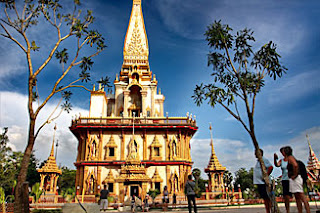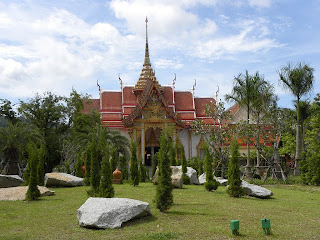Chalong Temple, Phuket
 |
| Wat Chalong Temple, Phuket |
Center of Phuket’s people’s belief, Wat Chalong, located in
tambon Chalong, Mueang Phuket district. It’s one of attraction said to be ‘a
must visit once in the life time’ when you come visit Phuket. This temple is
replete with history and legend. Many stories have been told about how miracles
perform there till these days. Wat
Chalong is official called ‘Wat Chaitararam’ by royal decree but there’s not
many people use that name. The temple location is near many other local
attractions of Phuket. The name ‘Chalong’ means ‘to celebrate’ or ‘festival’ in
Thai but many years ago the area was named ‘Chalang’ after local, fearing
Burmese invaders, had moved from Thalang district during the war between
Thailand and Burma.
 |
| Chalong Temple Phuket |
No one
knows exactly when the attraction was first established though many people
believe the original was built during the reign of King Rama II (1809-1842). It
was later relocated and since then has been renovated and augmented a number of
times. The most recent major addition to the temple was the construction of a
special ‘chedi’ or the Grand Pagoda to house a fragment of bone from the Lord
Buddha, called in the correct term as ‘Phra Borom Sareerikatat. The pagoda is
61.39 meters high and costing 66 million baht (around 2.12 million $USD). The
fragment was brought from Sri Lanka in 1999 and installed in the pagoda in
September 2002 in a consecration ceremony presided over by HRH Crown Prince
Maha Vajiralongkorn, representing HM the King and the pagoda’s officially named
‘Phramahathatchedi-Jomthaibarameepragat’. It becomes a famous attraction among
tourist both Thai and foreigner of its beauty and charming in respect of
architecture way and religious way along with Wat Chalong.
Wat
Chalong also plays a major part of Phuket’s history. During 19th
century Phuket was an important center of industry because of the influx of
wealth brought in through tin mining and many Chinese labors flocked into
Phuket in the end. Finally, some of them had formed a secret society called
‘Angyee’ and began to amass power.
 |
| Chalong Temple |
When
tin mine owners refused them the opium they had grown accustomed to they became
incensed. A small group of Angyee seized the Provincial Hall, killing people in
process. Many locals escaped to Wat Chalong and ran to Luang Poh Cham, the
Abbot, warning him of the imminent danger by the way he refused to escape and
stated that he who had been raised and studied at the temple would not run away
from it and so the locals decided to stay with him. As a Buddhist monk, Luang
Poh Cham could not physically fight the Angyee but he rallied people to fight
back whenever the Chinese attacked. The battle between them was fierce and the
Chinese even breached the temple wall at one
point. The breach can be seen at the temple to this day. Blessed and encouraged by receiving a religious talisman from
the Abbot, the locals fought back and retrieved victory over the Chinese and
finally destroyed the drugged and stupefied by opium labors. King Rama V
finally invited Luang Poh Cham to Bangkok after being informed about the
victory and promoted him to regional Abbot for Phuket and its surround
provinces and also bestowed the royal title of Chaithraram or Wat Chalong.



Comments
Post a Comment